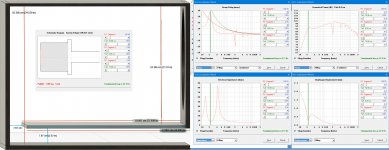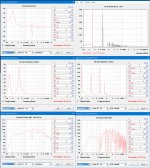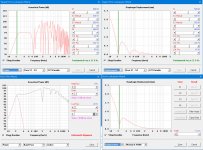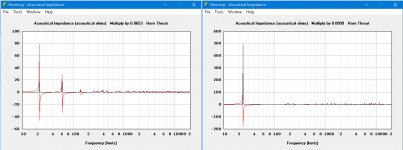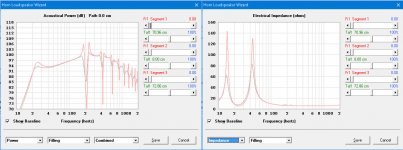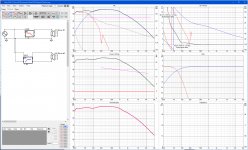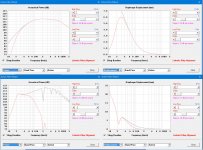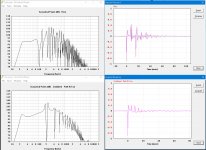If one combines 4 compression drivers, they can go theoretically lower to half the frequency with the same SPL? And any compression driver on a sufficiently large horn can be used with 1/4 the power with every octave down from the manufacturer specified value?
Even below the resonant frequency? If one would want to go to extremes and provided that the combination is perfect, a large number of smaller compression drivers could be used to play as low and one large compression driver?
Right.
Hmm, for manufactured compression drivers: If I ever knew, I've forgotten, but limit it to a half octave at most unless its Fs with no load attached is known to be lower.
In your example, there's a number of prosound compression driven line arrays, so if you find what driver is used, then you could compare with published performance specs to get your answer for high power apps, which for HIFI should give you enough of a buffer.
For DIY where you know the horn/driver system's complete specs, the driver's total usable BW is dependent on its specs, i.e. its upper and especially its lower mass corner, which governs how far down you dare push it. What I found is that even a little below it turns into a ~totally unloaded horn with the attendant 'clang'/'smoke letting', so caveat emptor applies.
GM
How do I judge these if most of the specs are very similar?]
Dunno, please Export your files.
GM
Thanks. This is one possible incarnation with 60 degs base opening angle. The fins are missing here but they are required and should be treated separately...
View attachment 820537 View attachment 820538
Electrovoice HR6040 🙂
GM, take a look at this MLTL and tell me what you think. I'm still trying to get closer to the group delay you achieved in your design, but maintain the sensitivity. The impedance peak is 10ohms lower in this design.
GM did I see you talking about how to convert the poly-fill reading in Hornresp to wool?
GM did I see you talking about how to convert the poly-fill reading in Hornresp to wool?
Attachments
Last edited:
Loosing output from reductive eqing doesn't take away from the benefits of having a high efficient/sensitive loudspeaker because those sonic attributes (dynamic contrast) are tied to the enclosure and driver physics.....reductive (and additive) eq only changes the signal level to the driver, not its output vs signal level relationship. So you may limit the total output of the system, but if you have a rising sensitivity to start with, along with high sensitivity/efficiency, you already have more total output then needed, (for home use). When eqing the response flat, of said system, it increases SQ by diminishing excursion needs in the upper range.
Run the sim with a higher voltage level (EG) to look at the excursion at higher powers to see if you will need a high pass filter to protect the driver. Hornresp can add the filter into the model to give you idea of how it would look.
I've kept a trend since I started modelling...I don't plan to ever reach 14mm-xmax which would peak at 121db @ 30hz (halfspace)... Are you maybe talking about protection, from DC and unmixed material in the studio? At the volume excursions minizes at tuning and at 20hz I'm back to 14mm still 121db. There will be two. How should I implement the HP or do I not need it, knowing that information? At 100db, xmax is at 5mm at 10db. So I think its good?
Last edited:
Below the tuning frequency the cone is uncontrolled and the excursion is rising quickly. The excursion line will continue below 10Hz in an upwards direction so what you see as 14mm at 10Hz might well be a lot more at 5Hz. So if you don't protect the driver with a highpass filter it's possible that material with very low thumps like from hitting an acoustic guitar body or electronic sounds with intentional or unintentional infrabass might give a fright.
Try adding a 6dB highpass at 15 to 20Hz in Hornresp and see what happens, from memory it's in the filter wizard.
Try adding a 6dB highpass at 15 to 20Hz in Hornresp and see what happens, from memory it's in the filter wizard.
In your example, there's a number of prosound com
For DIY where you know the horn/driver system's complete specs, the driver's total usable BW is dependent on its specs, i.e. its upper and especially its lower mass corner, which governs how far down you dare push it. What I found is that even a little below it turns into a ~totally unloaded horn with the attendant 'clang'/'smoke letting', so caveat emptor applies.
GM
Danley uses multiple coax compression drivers with combiner throat in the Jericho to:
- Compensate for the bad loading characteristics of the conical (Synergy) horn down low.
- Keep up with the mid and low drivers up high.
Usually, the driver's Fs more or less determines the lower usable limit. Distortion starts to increase rapidly way before Fs. By using multiple comp. drivers you may stretch the usable range a little, but I wouldn't expect any wonders. Comp. drivers aren't much different from multiple woofers in this respect.
Last edited:
Below the tuning frequency the cone is uncontrolled and the excursion is rising quickly. The excursion line will continue below 10Hz in an upwards direction so what you see as 14mm at 10Hz might well be a lot more at 5Hz. So if you don't protect the driver with a highpass filter it's possible that material with very low thumps like from hitting an acoustic guitar body or electronic sounds with intentional or unintentional infrabass might give a fright.
Try adding a 6dB highpass at 15 to 20Hz in Hornresp and see what happens, from memory it's in the filter wizard.
OK, how should I implement protection for my compression drivers? Passively right?
OK, how should I implement protection for my compression drivers? Passively right?
The group delay is inversely proportional to frequency :
Figure 17A : Phase, Time and Distortion in Loudspeakers
The crossover generally takes care of that but some manufactures include a physical protection capacitor to the tweeter to give some protection should the active or digital crossover fail and full band signal goes to the tweeter. If you do that you just need to measure with it in place to get the crossover right. The capacitance value would be quite high to avoid impacting the 200Hz intentional crossover though.OK, how should I implement protection for my compression drivers? Passively right?
I just had the longest debate with a guy about how I should build a tapped horn instead of MLTL. I feel like I destroyed most of his argument, but I will say that the tapped horn is a beast. I couldn't find a configuration that increased sensitivity over the desired passband vs what I was already getting with MLTL, plus the MLTL had better group delay and more using bandwidth in the uppers. Not to mention, the MLTL is dampened. Is there something I missed?
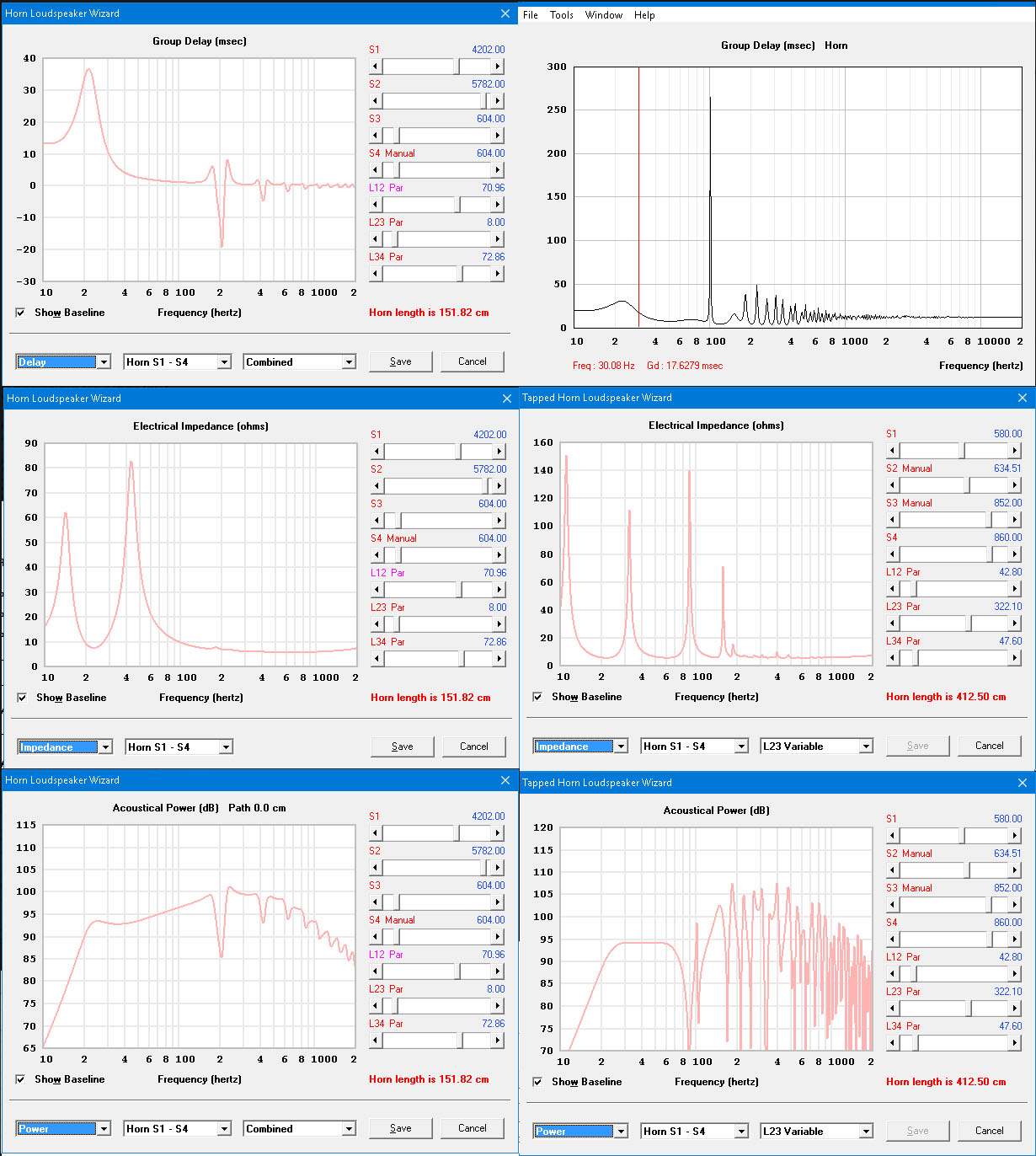
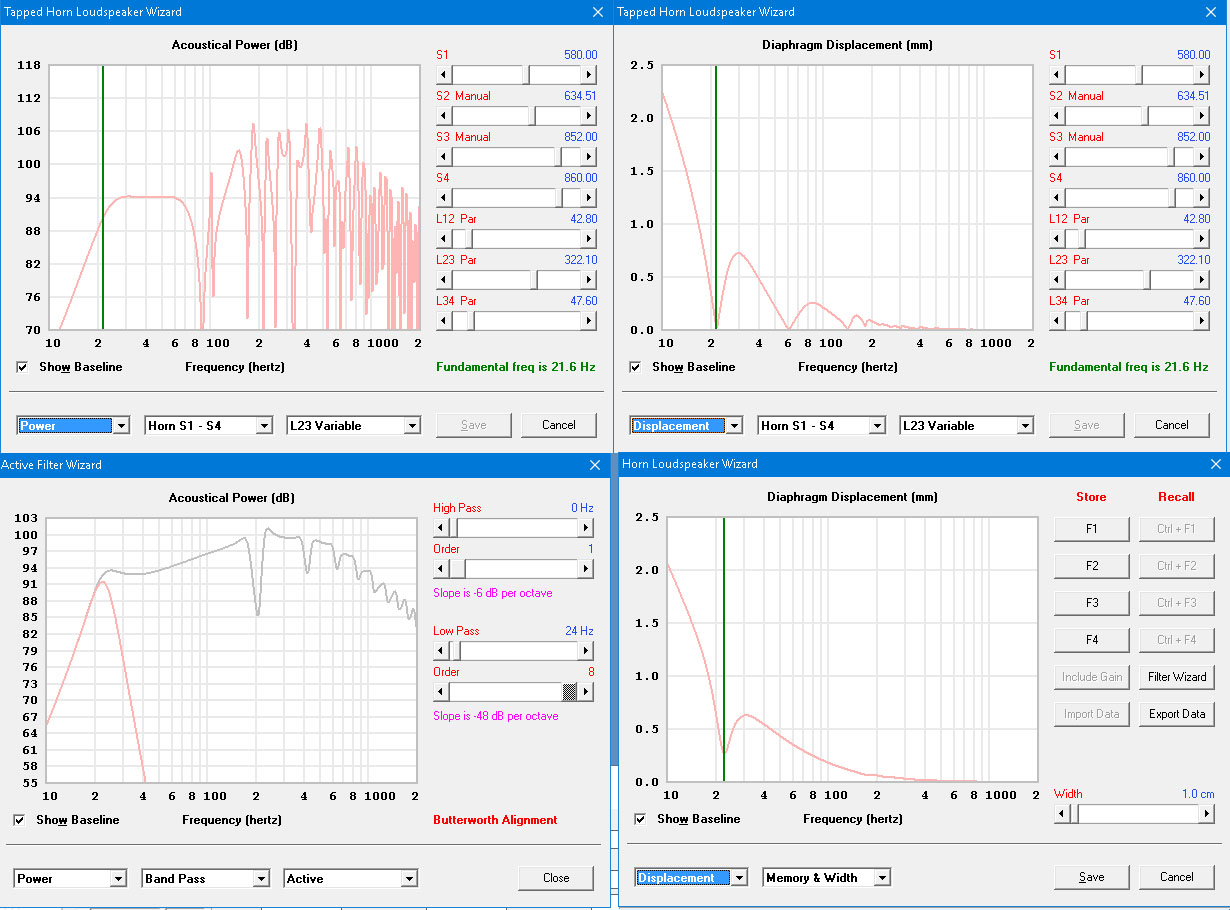
MLTL without fill
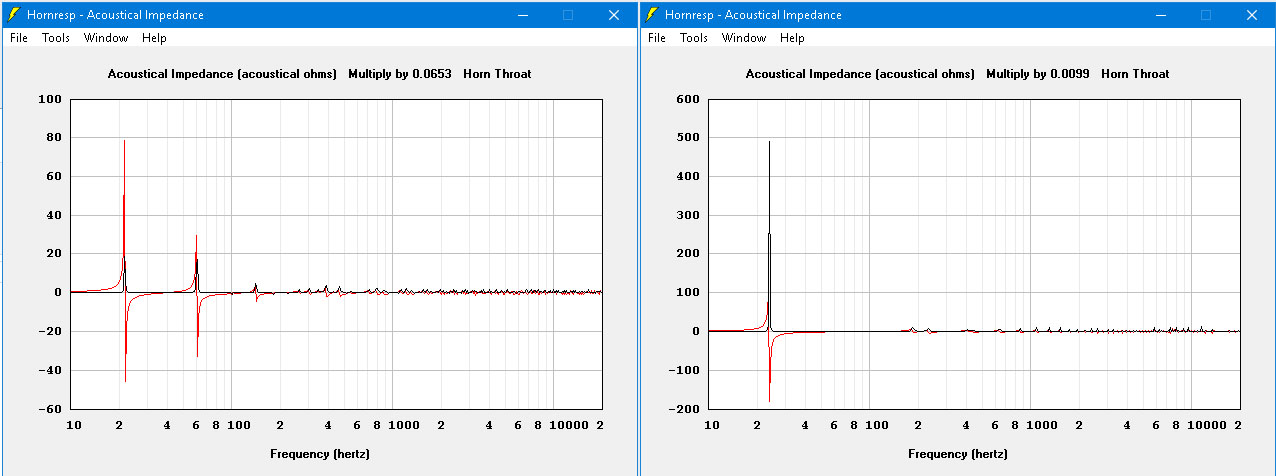
This did appear, around 400 some odd liters with a taper I think... but the extension is less
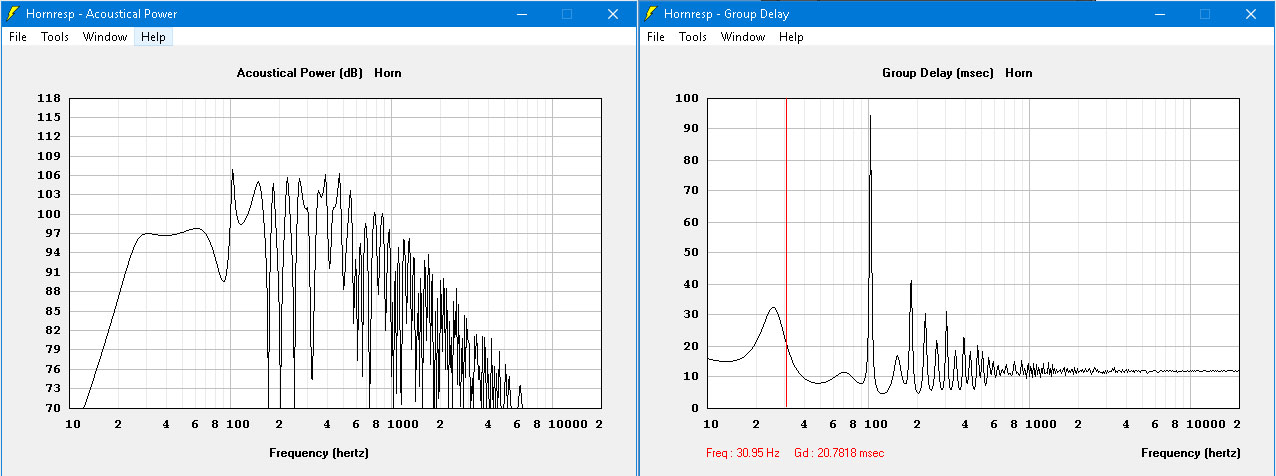
MLTL without fill
This did appear, around 400 some odd liters with a taper I think... but the extension is less
Attachments
Last edited:
I just had the longest debate with a guy about how I should build a tapped horn instead of MLTL. I feel like I destroyed most of his argument, but I will say that the tapped horn is a beast. I couldn't find a configuration that increased sensitivity over the desired passband vs what I was already getting with MLTL, plus the MLTL had better group delay and more using bandwidth in the uppers. Not to mention, the MLTL is dampened. Is there something I missed?
Personally, i'd avoid both.
Imo, a tapped horn is more about getting as much SPL per size of box, as is possible, than about SQ.
Its' a mixed phase device just owing to the substantial path length difference between the two sides of the driver.
I guess same can be said for a transmission line box, but I really don't know much about TL's, and frankly don't want to given the more than usual trial and error it appears tuning one would take. Could be wrong big time here though...
Oh, in case you haven't seen this, given your interest in the Axi...
Check out the last post on the link..How good are The Jubilees today? - Page 35 - Technical/Modifications - The Klipsch Audio Community
I love the fact you are pursuing taking the Axi as low as possible...can't wait to see how it works.
But also have to say, it's not a project/expense I'd be willing to undertake if I wasn't also willing to add some form of VHF driver..
Personally, i'd avoid both.
Imo, a tapped horn is more about getting as much SPL per size of box, as is possible, than about SQ.
Its' a mixed phase device just owing to the substantial path length difference between the two sides of the driver.
I guess same can be said for a transmission line box, but I really don't know much about TL's, and frankly don't want to given the more than usual trial and error it appears tuning one would take. Could be wrong big time here though...
Oh, in case you haven't seen this, given your interest in the Axi...
Check out the last post on the link..How good are The Jubilees today? - Page 35 - Technical/Modifications - The Klipsch Audio Community
I love the fact you are pursuing taking the Axi as low as possible...can't wait to see how it works.
But also have to say, it's not a project/expense I'd be willing to undertake if I wasn't also willing to add some form of VHF driver..
"can't wait to see how it works." or how it doesn't work lol, I'm not sure if the audience has picked on the idea that no one knows if it will work, rather if it does great, if not.....now we know lol...
Most of the comparison was done however, with the same crossover (500 or 550 Hz) for the two drivers. There's little doubt that the Axi 2050 doesn't quite have the same openness and clarity in the highs (and perhaps midrange) compared to the Radian 950BePB. While it benefits from being able to be crossed a little lower in the K-402, it's a drawback in other areas. It's sort of like listening to a larger piston driver in the highs compared to a smaller one. It certainly doesn't bad by any means and combined with K-402 and a woofer it trashes most so called high-end speakers out there. But it is lacking some of the "sparkle" and resolution of the Radian driver to my ears.
I read this before I bought the axi2050, there isn't much I haven't touched on the internet that has the words "AXi 2050" in it, thanks to google and an annual ~5 month layoff. More so because there is very little info there to begin with, only people with first name Bjorn has the driver...I bought the driver from a Bjorn....is Bjorn a name a title or both....anyway....Thank you for your enthusiasm...I just searched back a couple pages so that I could record some comments that you made into my "book of notes".
"it trashes most so called high-end speakers out there. But it is lacking some of the "sparkle" and resolution of the Radian driver to my ears." I'd like to think that we are spoiled....if only just some...
Last edited:
When you think MLTL, just say.....what if I could get the same response as a BR of same size... but with less group delay, and its dampened to adsorb excessive reverberation (hence lowered impedance peak) with a better performing terminus (port)......if you seen the response of my above MLTL without stuffing you wouldn't have any worries about stuffing technique, as far as stuffing is concerned in this design, the more I use the flatter it gets at the knee, so you would know when too much was too much.
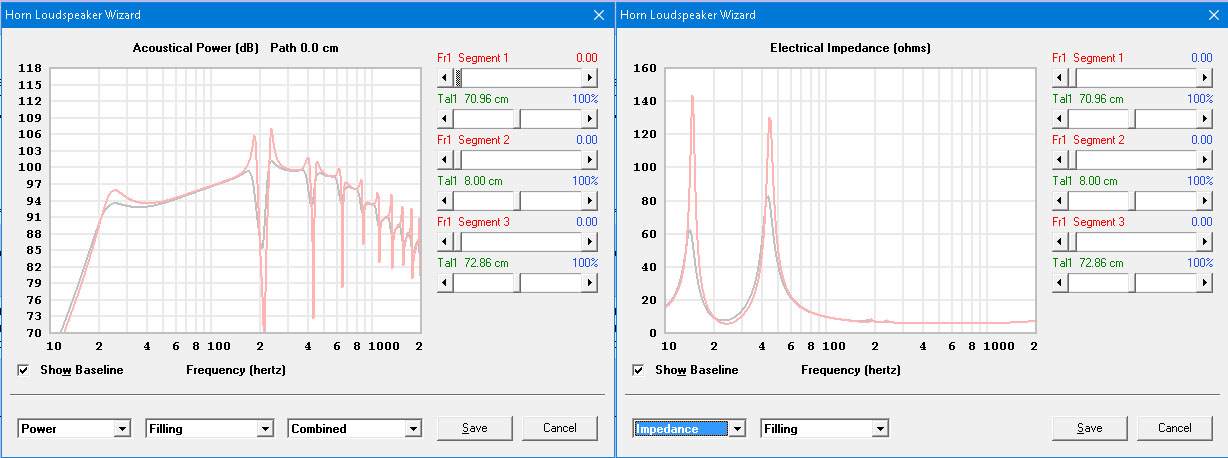
Attachments
Last edited:
I was able to move the HP lower by getting the response to "max volume" and watching excursion versus HP.
Attachments
Last edited:
Change the alignment type in one to butterworth and put a 1st order highpass in at 10 to 15Hz and see what happens to the excursion below tuning frequency. Then move the highpass frequency up and see the difference. You shouldn't need a 4th order filter for this, using IIR will add a fair bit of group delay low down if that is something you are trying to avoid.I was able to move the HP lower by getting the response to "max volume" and watching excursion versus HP.
Last edited:
Attachments
- Home
- Loudspeakers
- Multi-Way
- Is it possible to cover the whole spectrum, high SPL, low distortion with a 2-way?

